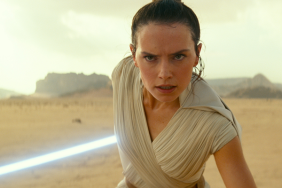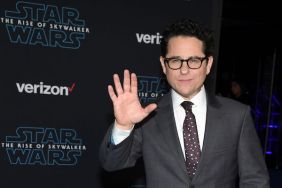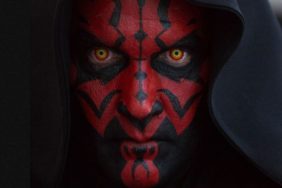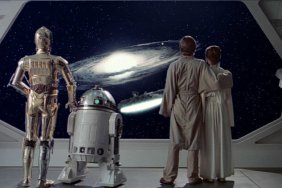2015 saw the release of the 11th Star Wars feature film. I think it was called The Force Awakens. You may not have heard of it. It had a very limited release, and it made very little money. Its followers are passionate, but represent a very small portion of the movie-going public at large, who typically spend weekends binge-watching huge pop phenomenon movies like Roy Andersson’s mega-hit A Pigeon Sat on a Branch Reflecting on Existence. Plus, only the most die-hard of deep-cut cinematic obscurities have heard of the original Star Wars anyway. Good luck finding it.
Check Out: Star Wars: The Force Awakens is the #1 Film of All Time in America, Sort Of
If you did manage to see the film, however, then you may be struck by the amazing creatures featured therein. Star Wars has a long and proud tradition of myriad bizarre background critters and bizarre looking aliens. The creature effects were masterminded by Neal Scanlan – an Academy Award winner for his work on 1995’s Babe – and Chris Corbould – an Academy Award winner for his work on 2010’s Inception.
Crave had the opportunity to talk monsters with the two monster men of Star Wars: The Force Awakens. If you haven’t heard of it, seek it out. Their work is pretty spectacular.
Crave: The creatures in the first six Star Wars movies were largely practical, while the creatures in the proceeding four were largely digital. This is a blend. What was the directorial decree on what you were allowed to do for The Force Awakens?
Neal Scanlan: Chris will verify this as well from his world. I think [director] J.J. [Abrams] was absolute that we use A New Hope as our point of starting, as our inspiration. I think you may have even seen interviews where he talks about seeing the movie as a young person, and having that tangible, real reaction to it. And I think that not only was that very important to him, but I think, secondly, what he also felt was that it would also be really important to the new cast, who would be playing the roles. As much as he could, he would set up a scene and practically live that scene and shoot that scene on every level. That was his mantra for the film.
Chris Courbould: Definitely. He felt that the original film – A New Hope – that trilogy was very practical because in those days, that’s what they had! Pre-digital effects. And one of J.J.’s ways of making The Force Awakens true to those films was to make everything as practically as he could. You get better reactions from the actors. An actor standing against a green screen explosion going off, their reactions are very different if they’re standing with two sticks of dynamite going off behind them. It’s a different world.
The only thing is, we do have the luxury now to use digital effects to move us even further forward with practical and creature effects. We can “paint” rigs out that we put in. So we’ve still got the practical side of it. We have the image. But these guys… it’s a great marriage between the three [VFX] departments. Really hand-in-hand.

Disney
Is there one creature ethos you prefer? Did you appreciate being able to work with so many practical effects?
CC: From my point of view, if they’d have done it along the lines of the Star Wars prequels, I wouldn’t have taken the job in the first place. I like to show the craftsmanship and skill of my crew in the art form we work in. As soon as they said “we want to do it as practically as we can,” I signed up for it. I was in there. If they went the other way, I probably wouldn’t have done it.
NS: I think there’s an addendum to that as well. You see, creatures, those things, what was amazing was that, to some extent, the craft of what we do has been forgotten a little bit. And that’s not a bad thing. It’s not a criticism. It’s a reality. The digital effects are just unbelievably brilliant, and they do so much. So, I think, what was interesting working for J.J. and [producer] Kathleen Kennedy right from the start was that they didn’t really have any preconceptions of what special effects could provide for them.
So it was a new journey for that as it was for us. So to answer your question, we never really stepped outside of what was possible. We never set ourselves up for a fall. Because the expectation was never such that they were asking for things that were impossible. They truly started with the feeling that nothing was possible, and everything on top was a bonus. So we built the whole thing, creature-wise and certainly drawing-wise, from that basis. This was all relatively new.
J.J. is a huge fan and an incredibly intelligent man when it comes to practical effects. He knows all about it. But, nonetheless, I don’t think he had ever really experienced being on set with it. So it was an awakening in all senses of the word – not to be too corny. But we all grew as a team, and as Chris said. We all grew as a team. We invented 110 characters in all.
The 110 characters in the background were all impressive and cool-looking. But there was one all-digital character in the foreground. What was the story of Maz Kanata’s invention?
NS: I think what was great – and it helped in the consistency of what we were doing – and, again, J.J. is incredibly trusting. He’s one of the people who has given us the most trust – so the concept designers were allowed to present designs to J.J. And when it came to Maz, she was the first thing they looked at. She went through a four- or five-month design phase. We had Yoda at one end of the scale, and E.T. at the other. When we found that design, and we had the “eureka” moment. At that point we made a life-size replica of the character, which was then picked up by the digital team.

Disney
Was there any point in the development process when Maz was an actor or a puppet?
NS: Yeah! Yeah! We explored all the possibilities. The definition was never the visual. It was all about performance. And Maz’s role in the film changed considerably. It was minor, then it was major, then minor, then major. Minormajorminormajor. And no one ever really knew how important Maz would be, and that was one of the driving decisions behind finally choosing digital as the best version. Because there’s no restraints in that world. And it allowed J.J. full creativity to find Maz’ place in the movie without worrying about having to deal with that in the day. So we had a perfect, perfect reason to use CG as much as we did.
Explain to me how the process works. Are you asked to create specifics, or is your assignment more along the lines of “Give me a room full of creatures?” How creative can you be?
NS: What we knew on this film is that it took place in several locations. Each location had a distinct feel about it. We’re in a desert, we’re in Maz’ castle. The idea was that we designed literally about a thousand characters. And then we spent time with J.J., and J.J. would pick characters that he thought were particularly suited to what he was looking for. And that created the “J.J. version” of the alien world. The secondary process from that was one of “Which characters most feel that they would be on Jakku, or in Maz’s castle?”
So once the selections were made in 2-D, then we’d go through the process of creating them as a physical entity. So we build them. We sculpt them. We mold them. We build suits. Then we rehearse them. They’re each given a little backstory as to who they are. So, they’re a piece of theater. Then we go onto the stage, onto the set on the day of the shoot, and they live out their role. The idea is that J.J. doesn’t see them as a special effect. He just sees members of the cast. He doesn’t have to worry about their performance. He doesn’t have to ask them to do anything specific. They are in Maz’ castle, and they’re enjoying hanging out in Maz’s castle just the same.
Was there anything either of you worked on that you became kind of attached to, but didn’t make it into the final film?
CC: Not really. You present stuff as such an early stage of production. You don’t really present him with fully-formed ideas and then ask “Do you like this or not?” You talk about it. If he’s not responding to something, you cut it off early on. I never had that problem.
NS: We had lots of designs. The concept guys were fantastic and given a big level of freedom. And they sketched some pretty cool stuff. And the great part of being part of the Disney/Lucasfilm world is that it’s all part of a larger, continuing life. So I hold out hope of seeing some of those ideas coming in later, in later movies. Because some of those designs… well, they just didn’t fit J.J.’s requirements.

Disney
CC: I think the thing is with J.J. is that he’s got an incredibly quick mind. I’ll give you an example. Rey’s speeder. It has to speed across the desert. It’s like a tractor engine without any wheels. To get it across the desert, we mounted it on wheels out the bottom and mounted it on a spoke chassis with a high-speed 100cc motorbike engine inside, so it can go 60 or 70 mph across the desert with a hidden driver inside, and Rey on top. But we built that, and showed it to J.J. He said “It would be really great if it banked from left to right!” Okay. Back to the workshop. We built a mechanism that can do 60 or 70 mph, but then bank from the left to the right. We took it back to him, showed him the footage. He said “Yeah! Yeah! What would be even better would be if it went up and down one or two feet!”
His brain! He never stops thinking. Once you think you’ve nailed something: “Oh yeah! A new thing! Improve it! Improve it!” But that’s the way he is.
Did you go joyriding?
CC: We… uh… we did. The nervous thing about that speeder, though, were financial reasons. We only made one of them. Which did give us problems. I desperately wanted two, because of one goes down, then you have another one to bring straight into the shot. With one, it was lit a pit stop team. Everytime the thing had done a run, everybody was in, checking the tire pressure, pumping everything up. I was nervous, but we got through it.
You have both won Academy Awards in the past. Where do you keep them?
NS: Mine’s in my hallway. So I walk in, and I have a modest wall of fame. It’s on my modest wall of fame.
CC: I have a big fireplace, a big log-burning fireplace, and it’s right on top of the mantlepiece.
I would have mine fashioned into a necklace.
[A hearty laugh all around.]
Top Photo: Disney
Witney Seibold is a contributor to the CraveOnline Film Channel, and co-host of The B-Movies Podcast. He also contributes to Legion of Leia, and Blumhouse. You can follow him on “Twitter” at @WitneySeibold, where he is slowly losing his mind.








